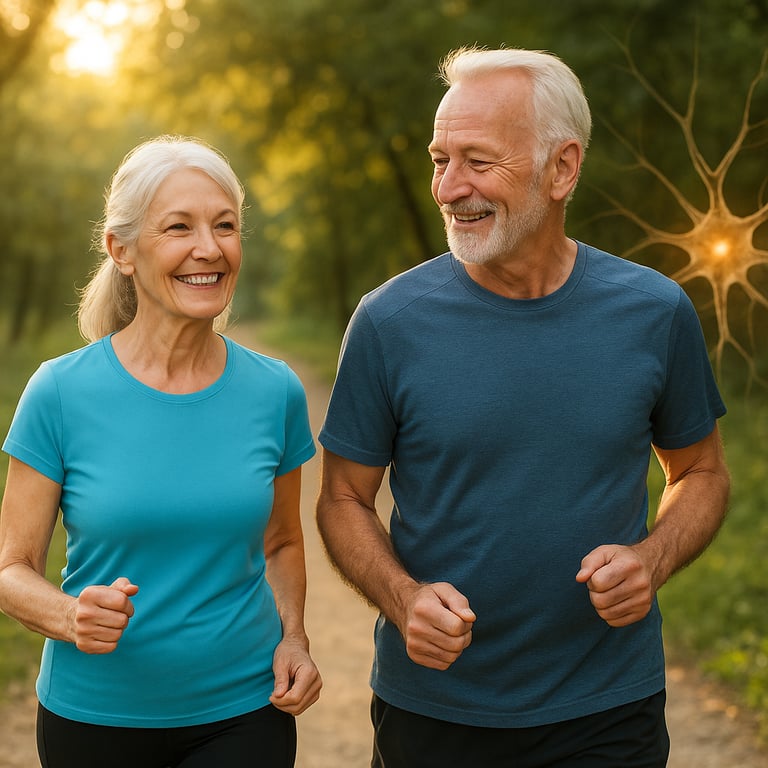Lifelong Movement = Brain Gold: New Evidence for Workout + Neuroprotection
New NIH study shows lifelong exercise protects brain health. Learn how strength, cardio & even gardening can keep your memory sharp after 60.
Bruce R Black
10/6/20252 min read


Lifelong Movement = Brain Gold: New Evidence for Workout + Neuroprotection
Okay, dear movers & shakers, gather 'round—here’s something to fire up your brain (literally). It turns out that moving isn’t just good for your joints and waistline—it’s one of the best armor we have against brain aging. A new NIH article even suggests that lifelong exercise helps preserve white matter, myelin integrity, and cognitive reserve in older adults. (National Institute on Aging)
So yes: strength training, walks, gardening, or dancing in your living room? All part of the brain-protective arsenal. Let’s dig into how this works, what the evidence says, and how senior and “active ager” folks can build a brain-friendly movement plan (without sounding like a gym ad).
What the NIH & Science Are Saying
The NIH’s “Lifelong exercise promotes brain health” report tracked cardiorespiratory fitness in adults aged 22 to 94, correlated with measures of white matter integrity. They concluded that maintaining aerobic fitness over time may help slow neurological deterioration. (National Institute on Aging)
In the review Physical Activity to Counter Age-Related Cognitive Decline (2025), authors find that both aerobic and resistance training improve cognitive outcomes in older adults. (PMC)
Animal & cellular studies confirm that exercise triggers neuroprotective pathways: increases in BDNF (brain-derived neurotrophic factor), reduced inflammation, enhanced neuroplasticity, and vascular support (better blood flow) to neurons. (PMC)
Meta-analyses show that higher physical activity is associated with lower risks of cognitive decline and dementia. (BioMed Central)
In short: movement = brain resilience.
Why Movement Beats a Detox Tea for Brain Aging
Let’s humanize the science with some bullet-friendly reasons:
Better blood flow = better fuel. Exercise increases cerebral perfusion and supports small vessels, which helps feed neurons.
Neurotrophic support. Movement boosts expression of factors like BDNF and IGF-1, which help neuronal growth and survival.
Reduced inflammation & oxidative stress. Exercise dampens chronic low-level inflammation that harms brain tissue.
Myelin protection & repair. The NIH study suggests lifelong fitness helps guard myelin, the insulating sheath around neurons, which tends to degrade with age. (National Institute on Aging)
Cognitive reserve & redundancy. Having “extra capacity” in neural networks gives us buffer against damage.
How to Build a Brain-Friendly Movement Plan (Especially After 60)
Here’s your playbook—customized for joints, mobility, enjoyment, and consistency.
🧰 Core movement types to include
Strength training (resistance)
Helps preserve muscle, supports metabolic health, and stimulates pathways protective to brain tissue.Aerobic / cardiovascular exercise
Walking, cycling, swimming, or brisk dancing — builds vascular health, which your brain absolutely loves.Balance, mobility, flexibility work
Yoga flows, tai chi, or simple stretch + mobility circuits keep you steady and reduce injury risk.
🗓 Sample weekly plan (for active agers/seniors)
⚠️ Adaptations for joints & mobility
Use machines or machines + free weights mix to reduce joint stress
Choose partial range or box-assisted versions if mobility is limited
Keep rep ranges moderate (8–12) initially; focus on control over load
Warm up thoroughly (joint rotations, dynamic leg swings)
Allow rest days and monitor how you feel
Bottom Line
Your brain wants movement — it's not a spectator. Lifelong exercise gives it what it craves: blood, challenge, repair signals, and resilience. For active agers, mixing strength, cardio, balance, and mobility is your best hedge against cognitive decline (and boredom).
You don’t have to sprint or deadlift 500 lbs. You just have to show up, adapt smartly, and keep the joy alive.
🔗 Key Research Sources
NIH / National Institute on Aging (2025):
Lifelong exercise promotes brain health in older adultsPMC Review (2025):
Physical Activity to Counter Age-Related Cognitive DeclinePMC Study on Neurotrophic Effects:
Exercise-Induced Neuroprotection: BDNF, IGF-1 & Brain AgingMeta-Analysis (BMC Public Health):
Physical activity & reduced cognitive decline risk
Beat Age With Ease
Empowering seniors to achieve fitness and health.
© 2025. All rights reserved.
"Disclaimer: The fitness and exercise information provided on this website is intended for educational purposes only. It is not a substitute for professional medical advice, diagnosis, or treatment. Consult your physician or a qualified health provider before starting any exercise program. The use of any information provided on this site is solely at your own risk. We do not assume liability for any injuries or health issues that may result from using our content."
💛 Found something helpful? Sharing is free, but if you’d like to keep the lights on and the ideas flowing, you can buy me a coffee below.
